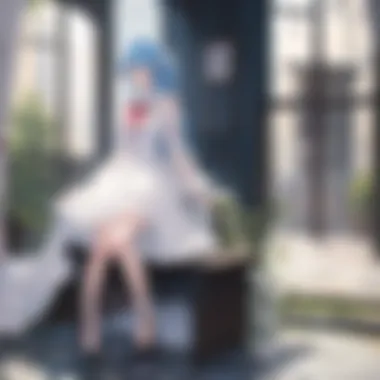Exploring Romance in Manga Novels: An Analytical Journey


Intro
Romance in manga novels represents a compelling segment of the larger graphic narrative world. This genre, rich in emotional complexities and character dynamics, has captivated millions of readers globally. Manga, as a medium, provides unique storytelling opportunities that traditional text may fail to achieve. The interplay between visual art and narrative drives readers into a beautifully intricate tapestry where love stories unfold against diverse backdrops.
The evolution of romance manga reflects not only the changing preferences of its audience but also the broader cultural shifts that occur over time. Examining the historical arc of this genre offers insights into societal norms, gender roles, and emotional expression across different eras and demographics.
This analysis will delve into the themes commonly explored within romance manga, such as unrequited love, friendship, and the complexity of relationships. An essential focus will be placed on character development, which forms the backbone of these narratives. Strong, multi-dimensional characters are paramount for engaging storytelling and resonate with readers on a personal level.
By dissecting various sub-genres, the article aims to shed light on the multifaceted nature of romance within manga: from shoujo, which targets young girls, to josei, aimed at adult women. Each of these sub-genres caters to specific demographic preferences, making them significant contributors to the landscape of manga literature.
Preface to Romance Manga
Romance manga occupies a significant niche within the broader manga landscape. This genre encompasses tales that explore the complexities of love and human relationships through the vibrant world of graphic storytelling. Understanding romance manga is essential for uncovering the various layers that contribute to its widespread appeal.
One major element is its ability to resonate with readers on a personal level. Love is a universal theme, and through manga, creators express various facets of romantic relationships. These stories provide an emotional escape and a means of exploring one's feelings, desires, and experiences.
Furthermore, romance manga reflects cultural nuances, allowing readers to engage with different perspectives on love and relationships across diverse societies. This connection fosters a more profound appreciation for the genre, as readers recognize their own experiences mirrored within the panels of manga.
Defining Romance Manga
Romance manga refers to a sub-genre of manga focused primarily on romantic relationships. These narratives often center around emotional connections, conflicts, and situations that arise from love. The genre can encompass various tones, from light-hearted to dramatic, and can blend with other genres such as fantasy or slice of life.
Typically, romance manga is categorized under two main demographics: shoujo and shounen. Shoujo targets a young female audience, often featuring strong emotional arcs and relatable characters. In contrast, shounen romance appeals to young male readers, incorporating action and adventure alongside romantic elements. This distinction is not rigid, as intersections and cross-genre influences emerge frequently.
The Popularity of Romance in Manga
Romance manga has gained immense popularity for several reasons.
- Relatable Content: The themes of love, heartbreak, and relationships are relatable to many readers, making the stories engaging.
- Diverse Characters: Romance manga boasts a wide range of characters from various backgrounds, facilitating a connection with diverse readership.
- Escapism: These narratives offer an escape from reality, allowing readers to experience emotions that may be absent in their own lives.
Recent trends also indicate a growth in readership beyond traditional demographics, with more adults exploring romance manga. This shift showcases the genre's versatility and timeless appeal.
"Romance manga serves as a mirror, reflecting the hopes and fears associated with love."
In summary, the introduction to romance manga lays the groundwork for a comprehensive exploration of its historical roots, themes, and cultural relevance. By addressing key elements such as its definition and popularity, readers gain crucial insights into the significance of this vibrant genre.
Historical Context
Understanding the historical context of romance manga is crucial for several reasons. It allows readers to appreciate the genre's roots and how it has transformed over time. In this section, we explore the early beginnings of manga and its romantic narratives, as well as the historical shifts that shaped the way we perceive romance today. The exploration of this background provides insight into societal changes, reader preferences, and the evolution of storytelling techniques within the genre.
Origins of Manga and Romance Genre
The origins of manga trace back to ancient Japan with illustrated narratives like Toba Ehon, which featured early storytelling methods combining images and text. However, the modern form of manga began to take shape in the late 19th and early 20th centuries. Influences from Western comics also started to play a role in its development.
In particular, the romance genre began establishing itself with works such as Nihon no Fūzoku and the rise of shoujo manga in the 1970s. Notable titles such as Boys Over Flowers provided readers with relatable characters and realistic romantic conflicts.
This embedding of romance within manga paralleled a shift in societal norms, where themes of love and relationship dynamics began to resonate with readers. As Japan transitioned through different historical phases, the representation of romance and relationships evolved simultaneously, reflecting broader cultural sentiments of love, desire, and companionship.
Evolution of Romance Manga Over Decades


The evolution of romance manga can be divided into several key phases, each characterized by distinct themes and artistic styles. In the 1980s, the genre experienced a boom, with the introduction of complex female protagonists navigating intricate emotional landscapes. Popular series, such as Maison Ikkoku, showcased deeper romantic narratives that explored themes of longing and personal growth.
In the 1990s and early 2000s, the adaptation of romance manga into anime expanded its reach significantly. This era saw the fusion of fantasy and romance, introducing supernatural elements that attracted a broader audience. Titles like Sailor Moon incorporated romance into action plots, emphasizing both heroism and love.
Recently, the emergence of digital platforms has allowed for new styles and sub-genres to flourish. Online webtoons and serialized publications are opening doors for diverse voices, presenting romances that are not only contemporary but also culturally nuanced. The integration of social issues related to diversity and representation has become more prominent, resonating with modern audiences.
The history of romance manga is not just about love stories; it is a reflection of societal norms and changing cultural perspectives.
In summary, the historical context of romance manga reveals a rich tapestry of creative expression that evolves with society. It shows how artists and writers adapt their narratives to fit the changing landscape of human relationships, making the genre a compelling area of study for enthusiasts and scholars alike.
Key Themes in Romance Manga
Understanding the intricate themes found within romance manga is vital for grasping their appeal and significance. These themes often explore the intricate dynamics of human emotions and relationships. This article will delve into three main themes: love and relationships, friendship and betrayal, and cultural influences on romance. Each element provides a lens through which readers can relate to and reflect upon their own experiences.
Love and Relationships
The theme of love and relationships is central to romance manga. It is not just about romantic love, but also about the various forms of love that exist in human connections. These narratives typically depict the struggles and joys encountered during romantic pursuits.
Many stories showcase the complexities of falling in love. Characters often face barriers, whether internal doubts or external pressures. This tension adds depth to their journey and keeps readers engaged.
Romance manga often emphasizes personal growth through relationships. Characters develop and change, which resonates with audiences. The portrayal of love can influence perceptions of what love means and how it can be expressed. Through different characters and their relationships, readers might reflect on their own feelings and experiences.
Friendship and Betrayal
Friendship and betrayal are themes that significantly shape narratives in romance manga.
Friendships often serve as a backdrop to romantic relationships, influencing character choices and actions. A deep bond between friends can complicate romantic feelings, adding layers to the story. This complexity can make the eventual romantic resolution more impactful.
On the other hand, betrayal can create dramatic tension. It raises questions about trust, loyalty, and the consequences of choices. Characters might betray friends or partners, leading to conflicts that must be resolved. This exploration mirrors real-life dilemmas, allowing readers to think critically about their own relationships.
Cultural Influences on Romance
Cultural influences play a crucial role in shaping romance manga narratives. Different cultures portray love in unique ways, which can be reflected in the stories.
In Japan, societal expectations often appear in romance manga. For example, themes of obligation and duty can influence character behaviors. This may differ from Western portrayals, where individual desire might take precedence.
Additionally, cultural elements can determine character interactions and relationship dynamics. Readers encounter diverse norms surrounding love, marriage, and friendship. This exposure enriches their understanding of romance across cultures, highlighting both similarities and differences.
"Romance manga acts as a mirror, reflecting varying cultural attitudes towards love and relationships, and enriching the thought process of its audience."
Through these themes, romance manga becomes a medium not merely for entertainment but for exploring the complexities of human emotions. Readers can find solace, challenge their views, and form connections with characters and their journeys.
Sub-genres within Romance Manga
The sub-genres within romance manga play a crucial role in defining the reading experience and attracting a diverse audience. Each sub-genre caters to specific tastes and preferences, offering distinct narratives and character types that can resonate with readers on various levels. The appreciation for these sub-genres also reveals the complexity and richness present in romance manga, going beyond simple love stories.
Shoujo vs. Shounen Romance
Shoujo and shounen romance are two primary categories that significantly influence the portrayal of relationships in manga. Shoujo romance, aimed primarily at young females, emphasizes emotional depth, character development, and often features themes of self-discovery and personal growth. Commonly, these stories center around teenage girls navigating the complexities of love and friendship.


In contrast, shounen romance is targeted toward a younger male audience and tends to integrate action and adventure alongside romantic elements. While relationships are central, they often take a backseat to plot-driven narratives, showcasing more dynamic interactions and conflicts.
The difference in target demographics fundamentally shapes reader expectations, creating a diverse array of themes and story arcs within the romance genre. Readers may find themselves drawn to one sub-genre over the other based on how they resonate with the storytelling style and character portrayals in these narratives.
Historical Romance Manga
Historical romance manga engages readers by placing romantic tales within specific historical contexts. This sub-genre can serve as a lens to explore past eras, cultural traditions, and societal norms. The allure lies in the juxtaposition of romance against a backdrop rich with history and artistry.
Common themes in historical romance include class differences, political intrigue, and the exploration of forbidden love. Titles like Boys Over Flowers and Kimi ni Todoke often incorporate historical elements while still remaining relatable to modern readers.
Through this melding of history and romance, authors capture the essence of their chosen era. Moreover, readers can experience the struggles and triumphs of love that transcend time.
Fantasy and Supernatural Elements
The inclusion of fantasy and supernatural elements expands the boundaries of romance manga, allowing for creativity and imaginative storytelling. This sub-genre often features mythical beings, alternate realities, and magical abilities intertwined with romantic plotlines.
Stories where characters possess unusual powers or dwell in fantastical worlds challenge conventional relationships' norms. For example, series like Fruits Basket and InuYasha merge elements of magic with love, creating a unique panorama that invites readers into their fantasy realms.
The appeal of this sub-genre lies in its ability to transport readers to worlds where the impossible becomes possible. It encourages exploration of love beyond earthly constraints, inviting a broader understanding of relationships and connections.
"The richness of sub-genres within romance manga not only reflects readers’ preferences but also supports the evolution of storytelling in the genre."
Readers often gravitate toward specific sub-genres depending on their interests and life experiences. These distinctions allow for connection and relatability, enriching the overall romance manga landscape.
Character Development in Romance Manga
Character development is a vital component of romance manga. It shapes the narrative and enhances the emotional connection between the audience and the characters. In this genre, characters are often mirrors of real-life experiences, facing trials and growth that resonate with readers. Through well-crafted arcs, these characters evolve, reflecting personal struggles, triumphs, and romantic entanglements.
The depth of character development can significantly affect the storytelling. For protagonists, their journey often involves discovering their own identities and desires amid romantic dynamics. This exploration not only strengthens the plot but also fosters empathy, ensuring readers form meaningful connections with the characters.
Protagonists and Their Journeys
Protagonists in romance manga typically embark on transformative journeys. They often start with personal dilemmas that hinder their ability to embrace love. These issues range from insecurities and misunderstandings to past traumas or societal expectations. As the story unfolds, protagonists face numerous challenges that compel them to grow.
For instance, a common trope is the protagonist's struggle to confess their feelings. This internal conflict can lead to various dramatic situations, engaging the reader. The resolution of these arcs usually showcases personal growth, leading to stronger relationships. The effectiveness of this journey lies not only in romantic fulfillment but also in self-discovery and acceptance.
Antagonists and Their Roles
In romance manga, antagonists serve a crucial purpose beyond merely opposing the protagonists. They often embody the challenges and obstacles the main characters must confront. The motivations behind antagonistic actions can vary, including jealousy, societal pressures, or past grievances.
By integrating antagonists, the narrative achieves depth, as these characters often have their own development arcs. Their perspectives can add complexity and highlight the growth journey of the protagonists. For example, an antagonist may initially seem malicious but may eventually reveal a backstory that elicits sympathy, thus blurring the lines of morality and enriching the story.
Supporting Characters and Their Significance
Supporting characters play an essential part in romance manga. They enrich the storyline by providing different perspectives on love and relationships. Often, they aid the protagonists in their journeys, offering advice, comedic relief, or a contrasting viewpoint that emphasizes the primary themes of the narrative.
These characters can also serve as romantic interests that help shape the dynamics within the story. Their interactions with the protagonists influence the latter's development. Sometimes, the supporting characters represent the consequences of decisions the main characters could make, providing cautionary tales or examples of what a relationship could be.
Cultural Impact and Audience Reception


Understanding the cultural impact and audience reception of romance manga is vital. This genre does not only tell tales of love but also mirrors societal norms, values, and expectations. It shapes how relationships are perceived and experienced, particularly among younger demographics. In recent years, the popularity of romance manga has extended globally, indicating its powerful reach and significance.
Romance Manga in Global Culture
Romance manga has transcended its origins in Japan to become a significant part of global pop culture. This genre appeals to a wide audience, cutting across age, gender, and geographic boundaries. Countries such as the United States, France, and South Korea have vibrant manga scenes, which are increasingly influenced by original Japanese works.
Readers often find themselves identifying with characters due to their relatable experiences and emotions. The themes of love, heartbreak, and personal growth resonate universally. Many romance manga titles, like "Fruits Basket" and "My Little Monster", exemplify cross-cultural appeal. They bring forth diverse storytelling that often reflects local cultural nuances, making the manga experience richer for an international audience.
Romance manga also affects social conversations around relationships. It challenges stereotypes and offers portrayals of romance that are sometimes nontraditional. This is important as it encourages readers to think critically about love and relationships in their own lives.
Fan Communities and Their Influence
The rise of digital platforms has facilitated the growth of fan communities surrounding romance manga. Sites such as Reddit and Facebook have become popular spaces for fans to discuss their favorite titles, share fan art, and connect with others who have similar interests. These communities are instrumental in promoting lesser-known works, helping them gain visibility.
Many fans participate in discussions that dissect themes, character arcs, and author intentions, creating a more engaged reader base. Fans often organize events, such as conventions or online meetups, where they can share their passion for the manga. This fosters a sense of belonging and community among readers, which further enhances the appeal and longevity of the genre.
Moreover, fan-made content, including fan fiction and illustrations, expands the universe of the original works. This not only showcases creativity but also emphasizes the impact these stories have on their audience. Readers are not just passive consumers; they become active participants in the world of romance manga.
In summary, the cultural impact and audience reception of romance manga is profound. It reflects and shapes ideas around romance and relationships while creating engaged communities of passionate fans. This ongoing dialogue enriches both the genre and the reading experience.
Modern Trends in Romance Manga
Modern trends in romance manga reflect the evolving landscape of both the genre and the medium itself. With changing societal norms and advances in technology, the way romance stories are created and consumed has taken a significant turn. Key to understanding this transformation are two main elements: digital publications and a focus on diversity and representation.
Digital Publications and Accessibility
Digital publications have revolutionized how romance manga reaches its audience. In the past, physical copies dominated the market, often limited by geographic boundaries and distribution challenges. Today, readers can access an extensive range of romance manga online through platforms like Crunchyroll Manga, Viz Media, and Kodansha. This accessibility allows fans around the globe to explore titles that were previously unavailable in their regions.
Additionally, the rise of webtoons and independent creators on platforms such as Tapas and Webtoon increases the variety of stories presented. These platforms often allow for quicker updates and a direct line of communication between creators and readers, fostering a sense of community. Readers can contribute feedback, and even influence storylines, making the reading experience more interactive.
Moreover, mobile devices have made it effortless for readers to engage with manga anytime, anywhere. The convenience of having thousands of titles at one’s fingertips cannot be overstated. This shift suggests that the romance manga genre is adapting to contemporary consumption habits, thereby broadening its reach and audience.
Diversity and Representation in Characters
Diversity and representation have become focal points in modern romance manga. Today’s audiences crave authentic stories that reflect a wide range of experiences and identities. Manga that incorporates characters from diverse backgrounds is increasingly popular. This shift not only elevates previously underrepresented narratives but also resonates with readers who seek relatable characters.
Aspects of representation include varying sexual orientations, genders, ethnicities, and cultures. This diversification leads to more complex story arcs and enriched character development. Readers are now able to see themselves within the stories, enhancing emotional connections to the narratives.
Furthermore, the inclusion of different cultural traditions and relationship dynamics broadens the genre's scope and invites a wider readership. Themes like LGBTQ+ acceptance, body positivity, and varied family structures are becoming common in romance manga. As a result, stories feel more relevant in today’s hyper-connected world.
The modern era of romance manga showcases a vibrant tapestry of narratives that challenge traditional norms and embrace diverse storytelling.
In summary, the exploration of modern trends in romance manga presents a rich field of discussion. Digital publications have reshaped the medium, while a focus on diversity and representation aligns the genre with contemporary societal values. This fusion of accessibility and inclusivity positions romance manga to not only thrive but also evolve further in the coming years.
Epilogue
The conclusion of this article serves as a pivotal moment to reflect on the multilayered aspects of romance in manga. It synthesizes the discussions presented throughout, highlighting how romance manga not only entertains but also provides a lens into the complexities of relationships, culture, and societal values. Understanding the future of romance manga is paramount for readers and creators alike, as it paves the way for innovative narratives and representation.
The Future of Romance Manga
The future of romance manga appears intertwined with several emerging trends that are likely to shape its direction. One significant aspect is the growing importance of digital platforms. The rise of webtoons and online serialization allows creators to gain immediate feedback and cater to diverse audiences with varied tastes. This instant access to content can also lead to experimental narrative styles that challenge traditional forms.
Diversity and representation in characters will likely remain a critical theme. As society evolves, so too do the expectations from manga creators. Readers seek stories that resonate with their experiences and reflect an array of backgrounds and identities. Consequently, the call for authentic portrayals of love beyond the typical pairings enhances the richness of romance narratives.
Moreover, we may see a blend of genres where romance fuses with elements of science fiction, horror, or even thriller. Such combinations could captivate broader audiences and introduce romance stories that defy conventional tropes.
"Understanding the trends of romance in manga is essential for appreciating its evolution and anticipating where it may lead."







